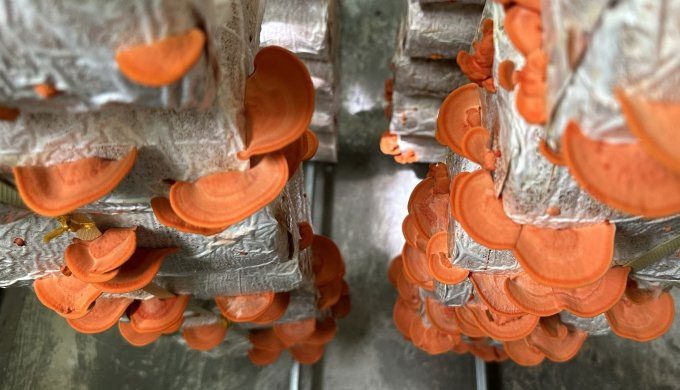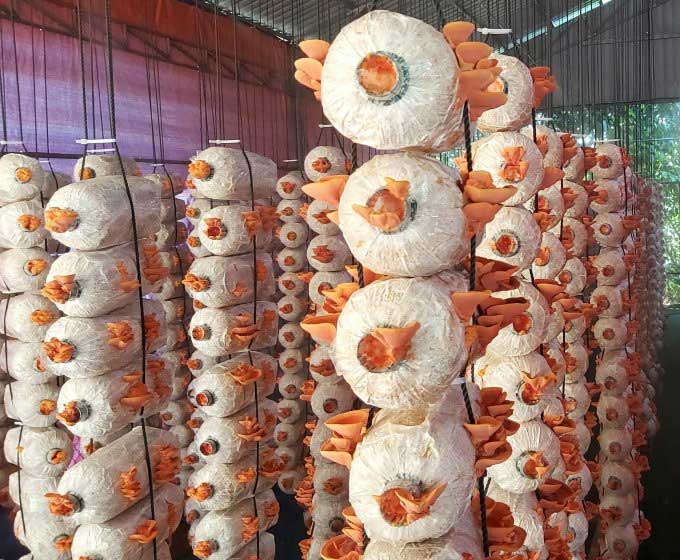Using corn cobs and rice husks, Dr. Trần Đức Tường has researched the cultivation of red reishi mushrooms instead of rubber wood sawdust, achieving higher yields and better bioactive compounds.
Since 2015, Dr. Trần Đức Tường, 53, from Đồng Tháp University, began researching the utilization of corn cobs and rice husks for growing red reishi mushrooms. Previously, mushroom growers typically used rubber wood sawdust, but research experiments indicated that the nutritional content of corn cob materials is higher, leading to increased yields and economic efficiency.
Dr. Tường mentioned that corn cobs and rice husks are always readily available and abundant in the Mekong Delta region, which reduces transportation costs and ensures a stable supply of raw materials compared to rubber wood sawdust that must be sourced from the Southeast region. These two by-products have high cellulose and nutrient content, making them very suitable for producing high-quality red reishi mushrooms. According to him, there has never been any research that effectively utilized these agricultural by-products before.

Red Reishi Mushrooms. (Photo: Research Group).
Red reishi mushrooms (Pycnoporus sanguineus) are among the 25 main medicinal mushroom species known for their high therapeutic value, rich in natural compounds beneficial to health. Dr. Tường stated that the original strain of red reishi mushrooms was collected from Tây Ninh Province.
According to the project leader, the most significant success of the research was identifying an appropriate substrate (corn cobs) and optimal conditions that help increase yields compared to traditional substrates. The experiment determined that the ideal substrate mixture ratio is 60% corn cobs and 40% rice husks, which is most suitable for the mushroom mycelium to grow well and quickly colonize the substrate bags. The harvested mushroom yield is high, achieving a biological efficiency of up to 20.52% (205.2 kg of fresh mushrooms per ton of dry substrate).
The pilot production model (2,000 substrates) applying the technological process from the research results achieved high efficiency, with biological efficiency of 20.71%, surpassing that of rubber wood sawdust cultivation (16.62%). He noted that the production cycle from the breeding stage to harvesting dried fruiting bodies of mushrooms averages about 4 to 5 months.
The research team has designed a production technology process that is simple, feasible, and can be implemented in accordance with the technical level and conditions of the local area. Currently, the technology process has been applied at the High-Tech Agriculture Application Center in Đồng Tháp Province and several home-based production businesses, and is ready to transfer technology to farmers and businesses for product commercialization. Dr. Tường further stated that using corn cobs and rice husks shows economic efficiency (for the model with 2,000 substrates) of 964.87%, higher than that of rubber wood sawdust cultivation at 727.68%.

Production facility for red reishi mushrooms. (Photo: Research Group).
Studies on toxicity and biological effects indicate that red reishi mushrooms have health-promoting properties, enhance immunity, prevent thrombosis, reduce blood lipids, stabilize blood glucose, possess antioxidant properties, protect the liver, and have antibacterial and anti-cancer effects, making them safe for consumption. Red reishi mushrooms have high medicinal and economic value, with dried products currently priced at over 2 million VND per kilogram, yet production costs are not high, allowing for year-round production from readily available and abundant raw materials.
His research project won first prize at the 16th Technical Innovation Competition in Đồng Tháp Province for 2020 – 2021. In 2023, Dr. Tường’s project was honored in the Golden Book of Vietnam Innovation.
| Dr. Trần Đức Tường is currently a lecturer at the Faculty of Natural Sciences, Đồng Tháp University. He graduated with a degree in Biology Education, then continued his studies for a master’s and doctoral degree in Biotechnology at Can Tho University. He has published 21 scientific works, led and participated in nearly 20 scientific and technological research projects at the ministerial, provincial, and grassroots levels, and published 5 textbooks and lecture notes. |


















































